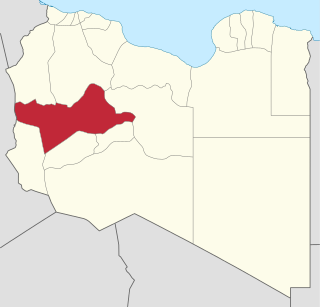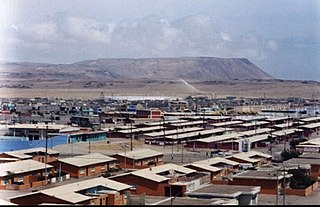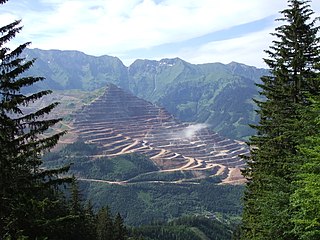Related Research Articles

Iron ores are rocks and minerals from which metallic iron can be economically extracted. The ores are usually rich in iron oxides and vary in color from dark grey, bright yellow, or deep purple to rusty red. The iron is usually found in the form of magnetite (Fe
3O
4, 72.4% Fe), hematite (Fe
2O
3, 69.9% Fe), goethite (FeO(OH), 62.9% Fe), limonite (FeO(OH)·n(H2O), 55% Fe) or siderite (FeCO3, 48.2% Fe).

The Timna Valley is located in southern Israel in the southwestern Arava/Arabah, approximately 30 kilometres (19 mi) north of the Gulf of Aqaba and the city of Eilat. The area is rich in copper ore and has been mined since the 5th millennium BCE. During early antiquity, the area would have been part of the Kingdom of Edom.

Wadi al Shati, sometimes referred to as Ashati, is one of the districts of Libya in the central-west part of the country. The area is mostly desert. Wadi al Shati District is named after the depression of the same name, Wadi Ashati.
Rittenhouse Gap is the name of a village in Longswamp Township in Berks County, Pennsylvania, United States, situated at 40°28′04″N75°37′47″W.

Sherman Mine is a closed open pit mine in Temagami, Ontario, Canada. It was a major producer of iron ore, starting production in 1968 and closing in 1990. Sherman was the largest open pit mine in Temagami, consisting of seven open pits known as the East Pit, South Pit, North Pit, West Pit and the Turtle Pits. The mine was discovered in the early part of the twentieth century, however interest was limited as a result of silver and gold discoveries in northeastern Ontario. While the Ontario government offered bounties to producers of iron ore, there was little interest in putting any iron mine into production as a result of cheaper Mesabi Range ores from the US and the Great Depression. It was only in the 1950s that Canadian steel producers started to investigate domestic supplies of iron ore. This would lead to the re-opening of the Moose Mountain Mine and development of the Adams, Sherman and Bruce Lake mines in Northern Ontario. The Sherman Mine operated in tandem with the Adams Mine in Kirkland Lake, and when the Adams Mine approached exhaustion of its economic ore reserves, the decision was made to also close the Sherman Mine. The surface infrastructure was removed and the site was abandoned. The waste piles are currently used by the municipality as a source of crushed stone for road works.
The Wadi ash-Shati' is a valley in west-central Libya, arising out of the Sawda Mountains, situated between the towns Wanzarik and Umm al-'Abid in the west and east, respectively. It is known for iron ore and manganese deposits.

Marcona District is one of five districts of the province Nazca in Peru. The district capital is San Juan de Marcona a port on the Pacific coast.
The mineral industry of Russia is one of the world's leading mineral industries and accounts for a large percentage of the Commonwealth of Independent States' production of a range of mineral products, including metals, industrial minerals, and mineral fuels. In 2005, Russia ranked among the leading world producers or was a significant producer of a vast range of mineral commodities, including aluminum, arsenic, cement, copper, magnesium compounds and metals, nitrogen, palladium, silicon, nickel and vanadium.
The Muncelu Mic mine was a large open pit mine in the western of Romania in Hunedoara County, 16 km southeast of Simeria and 387 km north-west of the capital, Bucharest. Muncelu Mic represents one of the largest iron ore reserves in Romania having estimated reserves of 6.5 million tonnes of ore. When it was operational it produced around 200,000 tonnes of iron ore/year. The mine also has a gold and silver reserves of around 5.4 million tonnes grading 1g/t gold and 8g/t silver resulting 173,000 oz of gold and 1.38 million oz of silver.
The Ghelari mine was a large open pit, also an underground iron ore mine in the western of Romania in Hunedoara County, 20 km south-west of Hunedoara and 411 km north-west of the capital, Bucharest. Ghelari represents one of the largest iron ore reserves in Romania having estimated reserves of 14 million tonnes of ore. The mine produced around 200,000 tonnes of iron ore/year.
The Ocna de Fier mine is a large open pit mine in the western of Romania in Caraș-Severin County, 25 km west of Reșița and 511 km north-west of the capital, Bucharest. Ocna de Fier represents the largest iron ore reserves in Romania having estimated reserves of 200 million tonnes of ore grading 25% iron metal. The mine produces around 10,000 tonnes of iron ore/year.

The Erzberg mine is a large open-pit mine located in Eisenerz, Styria, in the central-western part of Austria, 60 km north-west of Graz and 260 km south-west of the capital, Vienna. Erzberg represents the largest iron ore reserves in Austria, having estimated reserves of 235 million tonnes of ore. The mine produces around 2,153,000 tonnes of iron ore per year. It is also the site of the annual Erzberg Rodeo hard enduro race.
The Lueta mine is a large open pit mine in central Romania in Harghita County, 36 km west of Miercurea Ciuc and 299 km north of the capital, Bucharest. Lueta represents one of the largest iron ore reserves in Romania having estimated reserves of 6 million tonnes of ore. The mine produces around 10,000 tonnes of iron ore/year.

The Carajás Mine is the largest iron ore mine in the world. It is located in the municipality of Parauapebas, state of Pará in the Carajás Mountains of northern Brazil. The mine is operated as an open-pit mine, and is estimated to contain roughly 7.2 billion metric tonnes of iron ore, plus gold, manganese, bauxite, copper, and nickel. The mine is run by the Brazilian mining corporation Vale, and was initially part-owned with US Steel from 1970 to 1977.

The Tatanagar–Bilaspur section is part of the Howrah–Nagpur–Mumbai line and connects Tatanagar in the Indian state of Jharkhand and Bilaspur in Chhattisgarh. Part of one of the major trunk lines in the country, it passes through an industrial-mining area and handles high volumes of freight, particularly coal and iron ore.
The Cacova Ierii mine is a large open pit mine in the north-western of Romania in Cluj County. Cacova Ierii represents one of the largest iron ore reserves in Romania having estimated reserves of 16.6 million tonnes of ore grading 42% iron metal. The mine has the capability to produce around 415,000 tonnes of iron ore/year.
The Rudăria-Bănia mine is a large open pit mine in the south-western Romania in Caraș-Severin County. Rudăria-Bănia represents one of the largest iron ore reserves in Romania having estimated reserves of 70 million tonnes of ore grading 45% iron metal and 20% manganese metal. The mine has the capability to produce around 500,000 tonnes of iron ore/year.
The Iron Valley mine is a small iron ore mine located in the Pilbara region of Western Australia, 75 kilometres (47 mi) northwest of Newman, 270 kilometres (170 mi) south of Port Hedland, and 10 kilometres (6.2 mi) east of the Yandicoogina mine.

The mining industry of Libya does not contribute significantly to its economy. Mining resources are located in remote regions with limited accessibility. The fuel sector, including oil reserves and natural gas is the major revenue-generating industry.
References
- ↑ "Mineral deposits of Libya" (PDF). usaid.gov. 2012. Retrieved 2013-07-16.